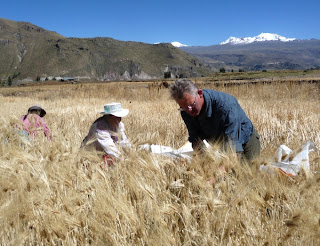Más de 120 mil personas, entre turistas y público local,
disfruraon este año de la escenificación del
Inti Raymi, considerada la festividad más solemne y grandiosa del
desaparecido imperio incaico.
Fuente fotos: El
comercio
 "The tour is designed for people who have an
extra day in the Colca valley and would like to spend it together with the
locals and actively share their daily life"
"The tour is designed for people who have an
extra day in the Colca valley and would like to spend it together with the
locals and actively share their daily life" Desayuno.
Desayuno. Giardino was present in the PTM
2012, the big meeting point of local tourist promoters with its international
counterparts. This was an event organized by the Peruvian
State, represented by Prom-Perú and
the private sector. In this event Giardino Tour Operator had the opportunity to
explain in details our new Peru
programs in hand with our recognized quality of service and security.
Giardino was present in the PTM
2012, the big meeting point of local tourist promoters with its international
counterparts. This was an event organized by the Peruvian
State, represented by Prom-Perú and
the private sector. In this event Giardino Tour Operator had the opportunity to
explain in details our new Peru
programs in hand with our recognized quality of service and security.  The canyon is home to the Andean Condor (Vultur gryphus), a
species that has seen worldwide effort to preserve it. The condors can be seen
at close range as they fly past the canyon walls, and are the region's most
popular attraction. 'Cruz del Condor' is a popular tourist stop to view the
condors, an overlook where condors soar gracefully on thermals of warm air
rising from the canyon. The condors are best seen in the early morning and late
afternoon when they are hunting. At this point the canyon floor is 3,960 feet
(1,200 m). Also Viscachas (burrowing rodents closely related to chinchillas)
are also common around the canyon rim, darting furtively among the rocks. Cacti
dot many slopes and, if they’re in flower, you may be lucky enough to see tiny
nectar-eating birds braving the spines to feed. In the depths of the canyon it
can be almost tropical, with palm trees, ferns and even orchids in some
isolated areas.
The canyon is home to the Andean Condor (Vultur gryphus), a
species that has seen worldwide effort to preserve it. The condors can be seen
at close range as they fly past the canyon walls, and are the region's most
popular attraction. 'Cruz del Condor' is a popular tourist stop to view the
condors, an overlook where condors soar gracefully on thermals of warm air
rising from the canyon. The condors are best seen in the early morning and late
afternoon when they are hunting. At this point the canyon floor is 3,960 feet
(1,200 m). Also Viscachas (burrowing rodents closely related to chinchillas)
are also common around the canyon rim, darting furtively among the rocks. Cacti
dot many slopes and, if they’re in flower, you may be lucky enough to see tiny
nectar-eating birds braving the spines to feed. In the depths of the canyon it
can be almost tropical, with palm trees, ferns and even orchids in some
isolated areas. Festivals throughout the year, including the Wititi festival
in Chivay, December 8–11; the Wititi has been declared the dance most
representative of the Arequipa
region, and named as a "cultural heritage" of Peru.
The Colca is also well known for two forms of crafts: goods knitted from 100%
baby alpaca fiber (hats, gloves, etc.), and a unique form of embroidery that
adorns skirts (polleras), hats, vests, and other items of daily wear and use.
Festivals throughout the year, including the Wititi festival
in Chivay, December 8–11; the Wititi has been declared the dance most
representative of the Arequipa
region, and named as a "cultural heritage" of Peru.
The Colca is also well known for two forms of crafts: goods knitted from 100%
baby alpaca fiber (hats, gloves, etc.), and a unique form of embroidery that
adorns skirts (polleras), hats, vests, and other items of daily wear and use.